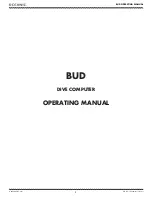
January 2006
3-12
Operation
Water-Soluble
Contaminants
Contaminants which readily dissolve in water, such as naturally
occurring salts, are detrimental to accurate vapor concentration
measurement by any condensation method. These materials readily
go into solution with the water condensate on the mirror surface, and
then reduce the vapor pressure in accordance with Raoult’s Law. As
the concentration increases with time, the saturation vapor pressure of
the liquid solution decreases.
The unit responds to this lower vapor pressure by elevating the mirror
temperature in order to maintain a vapor pressure that is in
equilibrium with the partial pressure of atmospheric water vapor. The
displayed dew point, therefore, drifts upward above the true dew
point. Because the measurement error increases gradually, it often
goes undetected.
To determine whether dissolved contaminants are affecting dew point
measurement, perform the following steps:
1.
Note the indicated dew point.
2.
Clean the mirror.
3.
Balance the detector by initiating a PACER cycle.
4.
Measure the dew point again.
If the new reading is lower than the first reading, it is likely that
soluble material was present in sufficient quantity to cause a
measurement error.
Gaseous Contaminants
When a gaseous material that has a higher condensation temperature
than that of water is present (even in very low concentrations), the
unit will eventually control on that material, rather than on water. The
system then displays the condensation temperature of the
contaminant, not of water. Such material accumulates on the mirror
only when chilled. In the normal atmosphere, gaseous contaminants
do not have a detectable effect.
Summary of Contents for Optica
Page 1: ...GE Sensing Optica General Eastern Dew Point Analyzer Operator s Manual ...
Page 11: ...Chapter 1 ...
Page 20: ...Chapter 2 ...
Page 43: ...Chapter 3 ...
Page 58: ...Chapter 4 ...
Page 80: ...Chapter 5 ...
Page 94: ...Chapter 6 ...
Page 95: ...Network Based Programming Introduction 6 1 Programming Screens 6 1 ...
Page 99: ...Chapter 7 ...
Page 109: ...Appendix A ...
Page 114: ...Appendix B ...
Page 115: ...Humidity Equations and Conversion Chart Introduction B 1 Vapor Pressure B 1 Humidity B 2 ...
Page 119: ...Appendix C ...
Page 120: ...Configuring the Serial Interface Wiring to a Personal Computer C 1 ...
Page 122: ...Appendix D ...
Page 127: ...Appendix E ...
Page 128: ...Glossary ...
Page 130: ...Appendix F ...
Page 133: ...Appendix G ...
















































